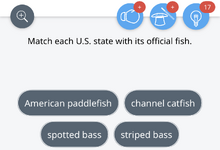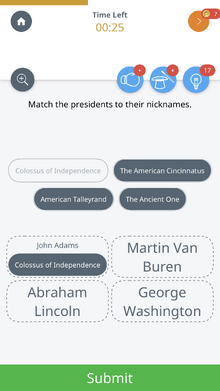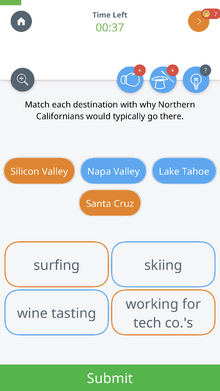MatchTwo is a drag-and-drop question type: instead of selecting items, you move them into the correct position.
Answering Interface[]
At the outset of a MatchTwo question, the Answering Interface provides movable objects right below the question text:

It's the player's task to drag those objects with a finger and drop them into the correct boxes. The container boxes appear below the movable objects:

When a movable object is dropped into a container box, the label of the container box shrinks and goes up in order to make room for the movable object. In the original location of the movable object, a "shadow" remains, and you can always move it back there (or directly to another box, in which case the items in the two boxes swap places). The screenshot below shows what it looks like when the first movable objects has been moved into the first container box:

After you have moved each object into the box that you believe it belongs in, tap Submit to have your input evaluated. If you run out of time, the positions of the objects at that moment are automatically submitted and scored.
Solution Display and Scoring Rules[]
The Solution Display for a MatchTwo question puts a green checkmark on each movable object that was placed in the correct box:

If a movable object is in the wrong box, it gets a red X (thereafter it is moved automatically into the correct container box):

For each correctly-formed pair, you get a fraction of the points winnable on this question. For each incorrectly-formed one, or for each movable object that you failed to put into any box, half that amount is deducted.
Most MatchTwo questions in Quizcover have four pairs. Mathematically, the scoring rules have the effect that you score points if two of four pairs (more than one third) are correct. If a MatchTwo question has only three pairs, a special rule applies so that you score even if you get only one pair right.
Boosters[]

As long as there will be at least two pairs left, you can use the Remove booster to throw out a pair that you're not sure you can correctly form. After tapping on the booster button, you get to select either a movable object or a container box, and the chosen object as well as its "partner" are removed. You won't get points for that pair, but at least you can avoid a deduction and reduce the number of potential combinations.

The Reveal booster provides a part of the correct answer. After you tap on the booster button, you get to select either a movable object or a container box, and the correct pair is then formed automatically for you. The movable object is then "locked" into the correct box, and you will get points for that pair. Also, you reduce the number of potential combinations.

The Hint booster reduces the number of possible combinations on a standard four-pair MatchTwo question from 24 to 4, and increases your chance of scoring at least some points (even if you were absolutely clueless in a particular four-pair situation) from 29% to 75%. It accomplished this by color-coding the Answering Interface: some objects turn orange and others turn blue, and a blue object can't possibly belong in an orange box, nor can an orange item ever belong in a blue box:

After you've used the Hint booster on a MatchTwo question, it gets a gray badge with a light gray question mark. If you tap on the booster button in that situation, a popup explains the meaning of the colors.
Retries[]
You can purchase up to three retries (four attempts then if one counts the original one).
Post-Solution Information[]
MatchTwo questions can have a multitude of post-solution information texts and/or links:
- the question as a whole can have post-solution information,
- each answer pair can have post-solution information, and
- each person, thing or concept that appears on the screen can have its own post-solution information.
Theoretically, a four-pair MatchTwo question could have 13 pieces of post-solution information (a number that won't be reached in practice).
Strategy[]
MatchTwo questions are often easier than they appear at first sight, and the reason is "solution by exclusion": by firstly matching the pairs that you're pretty sure of, you already reduce the number of potential combinations.
For the remaining pairs, some combinations will likely be more plausible than others. For example, if a question asks you to match different people with what they're famous for, a name like "LL Cool J" obviously looks more like that of a rapper than "Glenn Seaborg" (a scientist).
One can also look at it this way: a standard four-pair MatchTwo question is like playing a PickOne question with four choices in the beginning, three choices after the first pair has been formed, then two, and the last one falls into place.
The Hint booster is extremely powerful on MatchTwo questions. It's also the most expensive one, so whenever you collect your Daily Booster, it's probably best to view an ad so you get to choose the booster and to pick the Hint Booster.
Any standard four-pair MatchTwo question can be solved with the following booster-based strategy:
- Use the Hint booster first.
- Use the Reveal booster on an orange-colored item.
- Use the Reveal booster on a blue-colored item.
The rest will then be obvious.
User Benefits[]
A standard four-pair MatchTwo question covers as much ground as up to eight PickOne questions. If you match four presidents to their nicknames, you solve four PickOne questions that provide the president's real name and ask for the nickname as well as four PickOne questions that provide the nickname and ask for the president's real name.
By combining multiple facts in a single question, MatchTwo questions preserve the context of certain sets of facts. For example, it is more informative to get a question about four U.S. states at the same time than about only one.
The ability to solve questions by exclusion (as discussed in the Strategy section above) makes MatchTwo questions particularly engaging.
